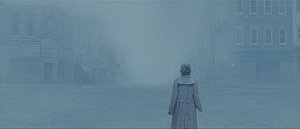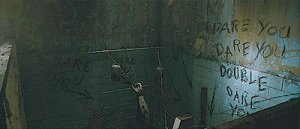Silent Hill
Tuesday, December 22nd, 2009 • Horrorthon Posts / Horrorthon Reviews
If you drew a straight line from The Matrix to Dark City and then extended the line along the same axis, you’d eventually hit Silent Hill, French director Christophe Ganz’ feverishly obsessive cinematic rendering of the acclaimed computer game series of the same name. This odd, grisly, beautiful movie was a box-office disappointment (and has many detractors), but I appreciate its elegance and sensual force more and more, each time I watch it. The detractors have a point—after a strong opening, the narrative quickly becomes snarled, complex and directionless, and the ending is unsatisfying—but I can’t make myself care. Other directors have attempted to do what Silent Hill does—to depict a sulphurous, demonic underworld directly beneath the surface of reality (notably, Francis Lawrence in Constantine) but no other movie I’ve seen achieves the particular, wonderfully creepy Edward Hopper-meets-H. P. Lovecraft atmosphere that seeps freely from this movie like steam from a street grating.
Have you ever driven down a dark, deserted country road late on a moonlit night, passed an unmarked turnoff, and (with a hint of unease), wondered, “What would happen if I left the highway and followed that road?” Silent Hill is about that unease—about the dream horrors that we imagine might be quietly hidden deep within underpopulated pockets of the nocturnal landscape. (Don’t take the turnoff—trust me.) Thirteen minutes after the movie starts, not-particularly-bright housewife Rose Da Silva (Pitch Black’s Radha Mitchell), traveling with her troubled, sleepwalk-prone daughter Sharon (whose ailments she’s trying to investigate), drives her Jeep Cherokee down that proverbial abandoned road—and off the edge of the sane universe. Silent Hill, the deserted West Virginia mining town that’s become a dimensional gateway into the depths of Hell, is the cause of Sharon’s somnambulistic distress, and the nexus of a neo-satanic curse that’s bent reality into a multi-layered puzzle-box of blood and evil straight out of Dante by way of Francis Bacon.*
One of the many strokes of genius in the Matrix movies is the creation of not one, but two fantastical environments: the “Matrix” itself (that stylish, subtly-tinted simulacrum of urban reality where heroes wear designer clothes and sunglasses, defying gravity as they kung-fu fight and dodge bullets) and the poisoned, rubble-strewn postnuclear “real world” where the same characters wear grime-smeared rags as they flee the red-eyed machines beneath a scorched sky. In almost exactly the same way, Silent Hill presents two different nightmare locales, existing right on top of each other (and overlaying yet a third dimensional plane—normal, sunlit, rain-drenched reality, where Rose’s husband frantically and uselessly searches for her), all three occupying the same physical space: the streets and buildings of the titular ghost town (a term that, obviously, may be taken literally and figuratively). The first level (called “Ash World” in the original game’s parlance) looks like reality…sort of. Nothing moves except the steady snow of ash that falls from the gray sky and coats the streets and buildings. Rose’s daughter is a constantly-glimpsed distant figure, endlessly running away like the faraway silhouettes in DiChirico’s paintings. I mentioned Edward Hopper, but Silent Hill draws from other surrealist masters including DiChirico, Balthus and Magritte (the yawning, sawtoothed, bottomless mist-shrouded cliffs that surround the town—shearing every exit road to make escape almost ludicrously impossible—resemble the vast, distant rock formations behind Magritte’s expansive landscapes).
“Ash World” would be frightening enough (and, in fact, contains the crucial clues with which Rose can solve the story’s deepest mysteries) if it were all the movie provided…but there’s more. Moments after Rose’s arrival, a lonely air-raid siren blares from somewhere nearby (a church steeple, as she eventually discovers) and she learns the most important rule of Silent Hill: when you hear that sound, be somewhere else. “The Darkness” (Silent Hill’s vastly more terrifying alternate reality) falls at regular intervals and for regular durations (again, reproducing the gameplay): the pale gray sky fades to black and all the world’s light vanishes. (I love the brutal efficiency of this particularly terrifying conceit: What’s the first rule of fear, anyway? Darkness.) This isn’t the conventional, spooky horror-movie dimly-lit environment: there is no light at all except for the unlucky visitor’s Zippo flame (and, later, a perpetually-dying flashlight) that allows flickering glimpses of the surrounding transformation of reality. It’s like the end of Disney’s Beauty and the Beast in reverse: every surface curdles and shreds like blowtorched paint melting from metal, revealing an obscene, viscera-spattered industrial-funk wasteland of blood, all steel grids, catwalks and fans, like an underground dance club painted by Hieronymus Bosch. “The Darkness” is where the mummified, barbed-wire-skewered corpses come to life and the monsters manifest out of thin air: the insects with screaming human faces; the half-formed infant blobs of corrosive flesh; the blood-drenched, knife-wielding, blindfolded nurses (played, in a brilliant directing choice that has been mentioned elsewhere on Horrorthon, by dancers), and, finally, the terrifying, giant-razor-wielding “pyramid-head” ghoul—the kind of demon Tolkien’s Nazguls would run from—who rules the landscape (even the menacing swarms of giant beetles flock to him).
All of this reproduces the game’s environmental logic, and its survival rules—twice, Rose escapes “The Darkness” simply by running out the clock. The movie is gameplay come to life, complete with MYST-style puzzles—Rose follows a map, finds the keys she needs, interprets cryptic messages—without the additional overlay of characterization or plotting that (for example) the Tomb Raider movies attempt to add. According to most of Silent Hill’s detractors, this is the problem: watching somebody else play a game wouldn’t be anyone’s first choice for a diverting entertainment. But I fundamentally disagree with the critique: in my opinion (which resembles my opinion of I Am Legend, another Francis Lawrence project) the environment is the movie, and, once the weirdness begins to cohere into a genuine story, things go astray. The always-interesting screenwriter Roger Avary (Pulp Fiction, Killing Zoe, Beowulf) provides a historical and motivational armature, sketching in the town’s noxious coal-mine fires, deviant church minions, and decades-old sins and curses that explain and define the multi-tiered nightmare locale I’ve described. But none of that really makes much sense, or difference. As Stephen King wrote (in Danse Macabre, the nonfiction book I’m always quoting), the basic triumph of The Twilight Zone was to present the nightmare “without explaining it or apologizing for it;” when Silent Hill follows this guideline, the results are peerless. (King fans, in fact, will find many of his favorite motifs, including his penchant for cursed towns, creepy religious sects, unsettling rifts in time and space and the horrors that await the hapless travelers who stumble into those dark, otherworldly realms. If King were a filmmaker rather than an author, he might make a movie like this.) Ironically, despite the aforementioned “just the game, filmed” critique, by attempting to go further, Ganz and Avary nearly undo the fine work they’ve done. As I said, I don’t mind: as far as I’m concerned, breathing life (and death) into a place like this—a town “from the dark side of the imagination” (as the Dark City trailers memory phrased it)—is achievement enough.

[BONUS VIDEO: If you haven’t seen the movie (or even if you have), you should watch the excellent trailer I’ve put up on my site. It’s very well done and conveys the peculiar, eerie tone of Silent Hill perfectly. MYSTERIES WITHOUT ANSWERS / SECRETS WITHOUT EXPLANATION / FEAR WITHOUT END.]
*The painter, not the philosopher.

